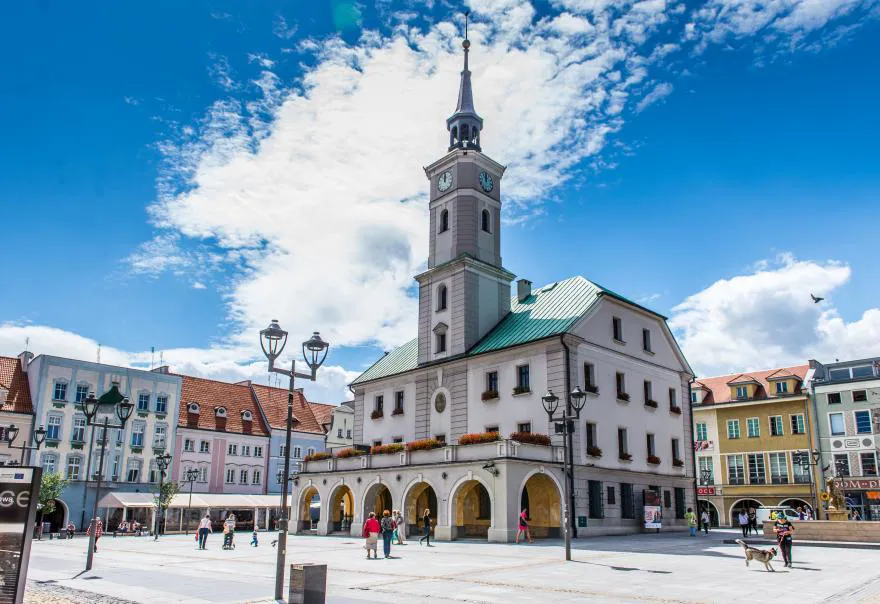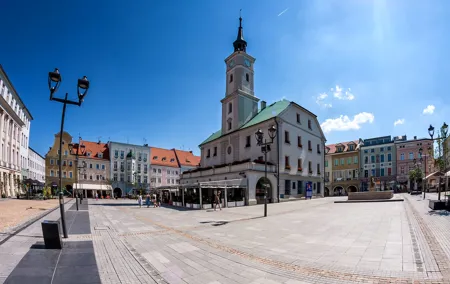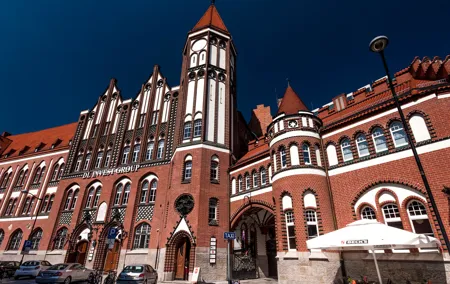Gliwice
A small mining town in the southeast of modern Poland was first mentioned in the chronicles in 1276. In the history of World War II, the town became the site of the infamous "Gliwice Provocation" - the staged attack on a German radio station and the formal pretext for the start of hostilities. The radio station, reminiscent of the Eiffel Tower, is the tallest wooden structure in the city.
The main attractions of Gliwice are located in the historical city center. The miniature Market Square becomes the main venue for Christmas celebrations. The remnants of the 13th-century town hall have been preserved, and visitors can see them in the basement restaurant of the modern Town Hall building. One of the main tourist draws of Gliwice is the magnificent Palm House, complete with greenhouses, ponds, and an aquarium.
Access to the museum exhibitions in the Piast Castle is free; among the exhibits are mammoth bones and a model of the old town. At the neo-Renaissance style residence of Caro-Villa, you can take a portrait framed by the bronze sculpture "Living Mirror." The most beautiful panoramic view of the Old Town, the Tatra, and Beskid mountain ranges is guaranteed for everyone who climbs the steps of All Saints Gothic church tower.
The main entertainment in Gliwice, including concerts and shows, takes place in the modern sports and entertainment complex Arena. Annually, the town in the Silesian Voivodeship hosts dozens of international folklore and street festivals. Fans of ecological and industrial tourism should take a tour of the Gliwice Canal with its lock system; the water level difference is 43 meters.
Gliwice is located at the intersection of Poland's main highways, the A1 and A4. It is a 20-minute taxi ride from Katowice-Pyrzowice Airport. A train from Warsaw to the city's stylish railway station takes just 3 hours.
Bankowa, 5
- Closed now
- $$$$
- Restaurants
In the vibrant surroundings of Gliwice, Pataya - Sushi Bar & Thai Restaurant offers a unique cu...
Zwycięstwa, 30
- Closed now
- $$$$
- Restaurants
- Desserts
- Bakeries
Restauracja Poziom + in Gliwice stands out as a top dining destination, offering a delightful b...
Dunikowskiego 4/4
- Open now
- $$$$
- Restaurants
ZOUZA Bistro in Gliwice offers a delightful dining experience with its modern, fusion, and heal...
Strzelców Bytomskich, 4
- Open now
- $$$$
- Restaurants
- Cafes
- Coffee houses
- Desserts
- Bakeries
KLAPEC Kawiarnia in Gliwice offers a delightful Italian dining experience with a variety of tem...
Rynek, 2
- Closed now
- $$$$
- Restaurants
- Pizzerias
In the lively square of Gliwice's city center, Domino's Pizza offers more than just a slice. Th...
Prymasa Stefana Wyszyńskiego, 14C
- Closed now
- $$$$
- Bars
- Pubs
- Craft Beer Pubs
- Restaurants
Miedziana Craft Beer & Chill in Gliwice offers a vibrant atmosphere perfect for those looking t...
Górnych Wałów, 11
- Open now
- $$$$
- Restaurants
- Cafes
Karmnik. Kawa I Ziarno in Gliwice offers a charming spot for anyone looking to enjoy a relaxed ...
Piwna, 8
- Closed now
- Restaurants
Akira Sushi & Ramen in Gliwice offers a delightful dining experience, combining the rich flavor...
Dworcowa, 30
- Closed now
- $$$$
- Restaurants
Czeska Pivo I Knedliki in Gliwice offers a delightful escape with its authentic Czech cuisine a...
Plebańska, 7
- Closed now
- $$$$
- Restaurants
- Desserts
- Pizzerias
TitoTito in Gliwice combines the charm of Italian cuisine with the warmth of a cozy atmosphere....
Pszczyńska, 315
- Open now
- Museums
- Art Museums
- Theme Parks
Funzeum in Gliwice is a vibrant escape perfect for families and art enthusiasts alike. With a r...
Pszczyńska, 315
- Open now
- Theme Parks
House Of Air - Park Trampolin in Gliwice offers a vibrant mix of entertainment and theme park t...
Aleksandra Fredry, 6
- Open now
- Parks
- Gardens
Palmiarnia Miejska in Gliwice is a captivating oasis that offers visitors a chance to explore a...
Dworcowa, 28
- Closed now
- Spas
Thaisispa Masaż Tajski in Gliwice offers a rejuvenating escape for those seeking relaxation and...
Henryka Sienkiewicza 5
- Open now
- Parks
- Gardens
Park Im. Fryderyka Chopina in Gliwice offers a delightful escape in the city center. This park ...
Chorzowska, 56
- Open now
- Playgrounds
- Fitness Clubs, Gyms
- Theme Parks
AleGra in Gliwice offers a vibrant mix of activities appealing to both kids and adults. This en...
Zwycięstwa, 23
- Closed now
- Fitness Clubs, Gyms
Strike Bar in Gliwice offers a dynamic blend of entertainment and fitness. Renowned for its exc...
CH Forum, Lipowa 1
- Cinemas
Cinema City in Gliwice offers a fantastic entertainment experience for film enthusiasts of all ...
Kaszubska, 25
- Open now
- Parks
Park Chrobrego in Gliwice is a beloved green space offering a serene escape in the city. Highly...
Pszczyńska, 315
- Open now
- Theme Parks
Dinoworld in Gliwice offers a family-friendly escape with its impressive dinosaur-themed attrac...
Pszczyńska, 315
- Open now
- Attractions
Kolejkowo in Gliwice offers an incredible journey through miniature worlds that captivate both ...
EUROPA CENTRALNA wewnątrz Galerii na przeciwko kawiarni Grycan, Pszczyńska 315
- Open now
- Attractions
In Gliwice, the Wystawa Budowli Z Klocków LEGO® offers a vibrant experience packed with creativ...
Rynek
- Historical Buildings
Rynek in Gliwice is a captivating blend of history and modernity, offering visitors a chance to...
Tarnogórska, 129
- Open now
- Museums
- Parks
Radiostacja in Gliwice offers a unique blend of history and greenery that captivates visitors o...
Chorzowska, 98
- Open now
- Attractions
Tężnia Solankowa in Gliwice offers a serene escape infused with the soothing ambiance of salt t...
Dolnych Wałów, 8A
- Closed now
- Museums
The Muzeum W Gliwicach - Willa Caro offers a captivating journey through time, reflecting the g...
Zwycięstwa 34/U1
- Open now
- Restaurants
- Cafes
- Coffee houses
In the vibrant city of Gliwice, Alahamora Gildia Czarodziejów offers a whimsical escape into th...
Pod Murami 2
- Closed now
- Museums
- Castles
Zamek Piastowski in Gliwice stands as a remarkable relic of the late Middle Ages, showcasing re...
Jana Pawła II, 5
- Churches, Cathedrals
In Gliwice, the Katedra Świętych Apostołów Piotra I Pawła stands as a remarkable example of Got...
Raciborska, 2
- Open now
- $$$$
- Bars
- Pubs
- Sports Bars
- Restaurants
Ministerstwo Śledzia I Wódki in Gliwice is a lively spot perfect for those looking to enjoy a c...
Jana Matejki, 3
- Closed now
- $$$$
- Bars
- Pubs
- Breweries
IBU Craft Beers in Gliwice offers a vibrant nightlife experience with a moderate price tag. Wit...
Krupnicza, 19
- Closed now
- $$$$
- Bars
- Clubs
- Lounge Bars
- Restaurants
In the vibrant city of Gliwice, Hola Tapas Bar offers a delightful blend of flavors and experie...
Zygmunta Starego, 24a
- Closed now
- $$$$
- Bars
- Wine Bars
Wine Bar Lofty - Skład Wina in Gliwice offers an exquisite nightlife experience for wine enthus...
Plebańska, 14
- Closed now
- $$$$
- Bars
- Pubs
- Cocktail Bars
- Lounge Bars
Takk Bar & Lounge in Gliwice offers a vibrant nightlife experience with a touch of elegance. Kn...
Stanisława Dubois, 22
- Closed now
- $$$$
- Bars
- Clubs
- Restaurants
CLUB 80 By DREAM CLUB in Gliwice offers a vibrant nightlife experience with its blend of a bar,...
Zwycięstwa, 6
- Closed now
- $$$$
- Bars
- Pubs
- Clubs
- Cocktail Bars
- Restaurants
- Cafes
Pierwsza Polka in Gliwice offers a delightful mix of nightlife and culinary experiences. Known ...
Pszczyńska, 29
- Closed now
- $$$$
- Bars
- Pubs
Hearts Pub in Gliwice offers a vibrant nightlife experience at a moderate price point, with cos...
Łużycka, 24
- Open now
- $$$$
- Bars
- Clubs
- Lounge Bars
Stołówka Studencka U Piotra in Gliwice is a vibrant spot for those seeking affordable nightlife...
Plebańska, 9
- Closed now
- $$$$
- Bars
- Pubs
- Sports Bars
Koneser Pub in Gliwice offers a dynamic nightlife experience with its inviting and friendly atm...
Pszczyńska, 315
- Open now
- Malls
Europa Centralna in Gliwice offers a vibrant shopping experience for everyone. With a 4.3-star ...
Lipowa, 1
- Open now
- Malls
Forum in Gliwice is a vibrant shopping destination praised for its spacious and bright layout, ...
Rybnicka, 205
- Open now
- Malls
Factory in Gliwice is a shopping destination where convenience meets comfort. Inside, you'll fi...
Jana Nowaka-Jeziorańskiego, 1
- Open now
- Malls
Centrum Handlowe Arena in Gliwice offers a pleasant shopping experience with an impressive 4.3-...
Kujawska, 112
- Closed today
- Markets
Giełda Samochodowa in Gliwice is a sprawling marketplace where you'll discover a diverse array ...
Zwycięstwa, 52A
- Open now
- Malls
Gliwickie Centrum Handlowe, located in Gliwice, offers an expansive shopping experience with a ...
Lipowa
- Closed today
- Markets
Targ Lipowy in Gliwice is a bustling hub for those who enjoy the lively ambiance of a tradition...
Kujawska
- Markets
Giełda in Gliwice is a vibrant market that offers a delightful mix of shopping and culinary exp...
Dolnych Wałów 1/lok.12
- Closed today
- Malls
- Fashion Stores
NUGA BEST Gliwice offers a unique combination of shopping and wellness in Gliwice. As the offic...
Toszecka 176
- Open now
- Malls
- Fashion Stores
Tucked away in the vibrant cityscape of Gliwice, Mobiway.Pl stands out as a hub for electric mo...












